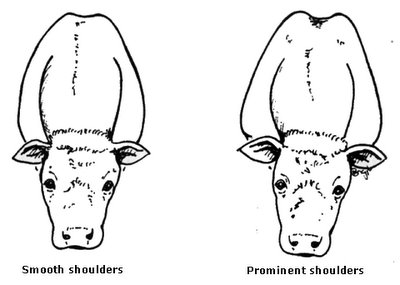Bull soundness - structural
This is an excerpt pertaining to "shoulders" but I recommend reading the entire NSW Agriculture’s Bull soundness - structural page as it provides some key points to look for in the selection of a bull.
The shoulders and front leg structure of the bull are shown in Figure 1 below. The shoulders are naturally sloping. A slope of 45–60 degrees is considered acceptable. A beast whose shoulder blade is tipped forward (straight-shouldered) has less angle at the shoulder joint and elbow joint and this reduces the shock-absorbing ability of these front joints.
Figure 1. Front leg and shoulder structure of the bull

The straight-shouldered bull tends to walk with a short choppy gait. He will carry his head low and may have difficulty raising his head much above his backline. Quite often the tip of the shoulder blade is prominent above his backline.
Usually, a bull that is straight in the shoulder will also be straight in the hind leg. These bulls are particularly prone to early breakdown through the wearing of the leg joints, and the onset of arthritis. While many straight-shouldered bulls will break down in the hind leg, they are also more susceptible to arthritis in the pasterns and knees of the front leg. Straight-shouldered bulls may also be straight in the pasterns, causing rapid wearing of the front of the hooves.
The shoulder should be smooth against the rib cage. Bulls whose shoulders are wide at the point of the shoulder (the base of the neck) or wide between the shoulder blades (when observed from above) may throw heavily shouldered calves, increasing the chance of calving problems (see Figure 2).

Bulls with straight shoulders may also affect the ease of calving. Any deviation away from the normal angles of the calf may produce an abnormal calf shape, causing calving difficulty.
It should be remembered that many things affect calving difficulty, and that calf size (weight) in relation to dam pelvic size will have the greatest effect on ease of calving.

<< Home